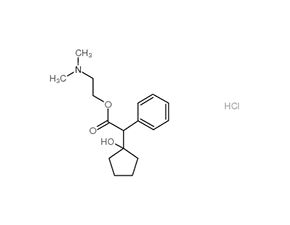
Cyclopentolate Hydrochloride
CAS No. 5870-29-1
Cyclopentolate Hydrochloride ( —— )
Catalog No. M21588 CAS No. 5870-29-1
Cyclopentolate Hydrochloride is a muscarinic acetylcholine receptors antagonist with Kis of 1.62 27.5 and 2.63 nM for M1 M2 and M3 receptors respectively.
Purity : >98% (HPLC)
 COA
COA
 Datasheet
Datasheet
 HNMR
HNMR
 HPLC
HPLC
 MSDS
MSDS
 Handing Instructions
Handing Instructions
| Size | Price / USD | Stock | Quantity |
| 10MG | 29 | Get Quote |


|
| 25MG | 59 | Get Quote |


|
| 50MG | 87 | Get Quote |


|
| 100MG | 156 | Get Quote |


|
| 200MG | Get Quote | Get Quote |


|
| 500MG | Get Quote | Get Quote |


|
| 1G | Get Quote | Get Quote |


|
Biological Information
-
Product NameCyclopentolate Hydrochloride
-
NoteResearch use only not for human use.
-
Brief DescriptionCyclopentolate Hydrochloride is a muscarinic acetylcholine receptors antagonist with Kis of 1.62 27.5 and 2.63 nM for M1 M2 and M3 receptors respectively.
-
DescriptionCyclopentolate Hydrochloride is a muscarinic acetylcholine receptors antagonist with Kis of 1.62 27.5 and 2.63 nM for M1 M2 and M3 receptors respectively.
-
Synonyms——
-
PathwayEndocrinology/Hormones
-
TargetAChR
-
RecptorM5 mAChR
-
Research Area——
-
Indication——
Chemical Information
-
CAS Number5870-29-1
-
Formula Weight327.85
-
Molecular FormulaC17H26ClNO3
-
Purity>98% (HPLC)
-
Solubility——
-
SMILESCl.CN(C)CCOC(=O)C(c1ccccc1)C1(O)CCCC1
-
Chemical Name——
Shipping & Storage Information
-
Storage(-20℃)
-
ShippingWith Ice Pack
-
Stability≥ 2 years
Reference
1.Ishikawa H Desantis L Patil P N . Selectivity of Muscarinic Agonists Including (±)-Aceclidine and Antimuscarinics on the Human Intraocular Muscles[J]. Journal of Ocular Pharmacology & Therapeutics 1998 14(4):363-373.
molnova catalog


related products
-
Moxalactam Disodium
Moxalactam sodium salt is an antibiotic compound more effective against Escherichia coli and Pseudomonas aeruginosathan cephalosporins.
-
Procainamide hydroch...
Procainamide hydrochloride is a class Ia antiarrhythmic drug that is structurally-related to procaine.
-
Theophylline
Theophylline is a methylated xanthine derivative; competitive nonselective phosphodiesterase inhibitor and nonselective adenosine receptor antagonist.



 Cart
Cart
 sales@molnova.com
sales@molnova.com


